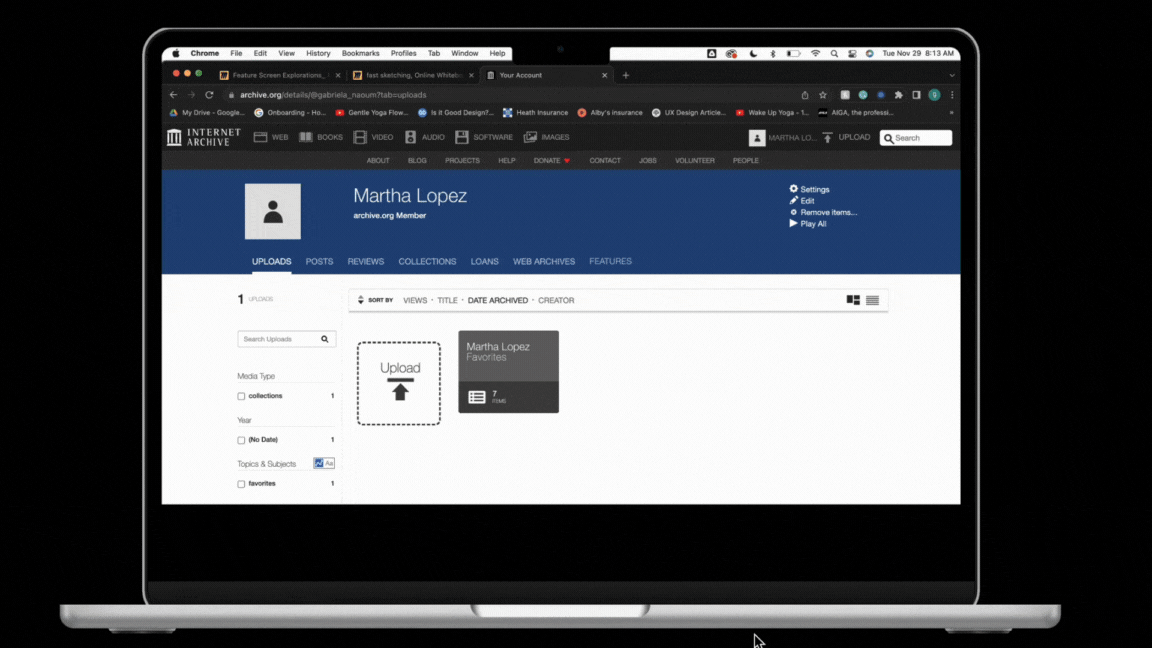Featured Articles - Internet Archive
It helps create scholarly and personal narratives about archive content and contextualize items from the extensive collections in the archive.
My Role:
UX Design Extern: Deriving various user groups on the platform. Designing and prototyping content writing tool on archive.org
Impact:
Aids 1M+ daily users to transform large content from the Internet Archive and helped empower users. Increased in engagement on the platform.
Tools used:
Figma, Miro, Google analytics, Asana, Notion, Adobe creative suite
About Internet Archive
The Internet Archive, a 501(c)(3) non-profit, is building a digital library of Internet sites and other cultural artifacts in digital form.
The mission of the Archive is to provide Universal Access to All Knowledge.
The Internet Archive serves about 5 million people each day, has about 15 million users in total, and is among the top 300 websites in the world.
Defining our process
The first step was to understand how the Internet Archive functions, which was followed by research, design, and iterative testing of the concepts.
Discovering our users
Step 1: Understanding the User base and Site map of Archive.org:
The sitemap of archive.org is a hierarchical outline or directory of all the web pages that have been crawled and archived by the Internet Archive, which is a non-profit organization that seeks to preserve digital content. The sitemap can be accessed by going to the following URL: https://archive.org/sitemap.xml.
Step 2: Audience demographic:
The audience demographic of Archive.org is broad and diverse, with users ranging from highly educated researchers and academics to casual internet users interested in exploring historical web content.
We decided to focus on:
31.08% - Age 25-34
Insights from the user analysis:
Researchers and academics: Archive.org is a valuable resource for researchers and academics who need access to historical web content and other digital resources.
Researchers in fields such as history, media studies, and computer science may find the content on archive.org particularly useful.
Archivists and librarians: Archivists and librarians may use archive.org as a source of inspiration and best practices for preserving and archiving digital content.
Web developers and designers: Web developers and designers may use archive.org to research the history of web design and development, and to explore how websites have evolved over time.
General internet users: They may use archive.org to revisit websites they used to visit in the past, or to explore websites and content they missed.
Quantitative and qualitative analysis
Qualitative Analysis
Spoke with 2 kinds of people.
1. Those who were trying to create some case study - potential users
2. Those who were already using Internet Archive - existing user to validate idea
Quantitative Analysis
Understood user demographics from archive.org stats available online, also tried to gather data on who uses Internet Archive most and why they use it
Finding1 : There are mainly 2 kinds of users, Users who consume and user who create content on internet archive.
Finding 2: There’s a gap between use internet archive to browse collections and then write about these collections. They often drop out aren’t able to contextualize the contents.
Finding 3: Users come to archive to use it for data, timeline of various topics or just reading through for research.
User journey maps
How might we... create a practical way to contextualize the articles collected on the Internet Archive.?
Identifying gaps in user journey:
Wireframing:
Designing the final solution and Iterations:
The content creation tool was placed in the front page so users could make use of it.
Reason for placing this new feature was to present it as beta feature and see how users engaged with it.
Three kind of templates to choose from, an article, data bubbles and timeline.
Elements in the final article
Name of contributors
Social media sharing and tags from metadata.
Sidebar with options to move between content parts, see the collections where the content is coming from and asking edits.
Space to add reviews and read previous reviews
related articles
Final Walkthrough
This project offers a way for people to share their understanding of history and encourages individually driven narratives and journeys through the items collected on archive.org. It is hosted on archive.org allows for the seamless incorporation of items from the archive into user-generated writing stored under a member's profile. These writings can be collaborative efforts by incorporating the forum discussions.
“It is a project to develop an integrated digital content tool for users of the internet archive.It helps create scholarly and personal narratives about archive content and contextualize items from the extensive collections in the archive, thereby supporting the mission of the archive to provide Universal Access to All Knowledge”.
Reflections:
This project offers a way for people to share their understanding of history and encourages individually driven narratives and journeys through the items collected on archive.org.
It is hosted on archive.org allows for the seamless incorporation of items from the archive into user-generated writing stored under a member's profile. These writings can be collaborative efforts by incorporating the forum discussions.
Writings should be selectively shareable, much like google docs. Writing would be published under the creative commons standard.
Users like librarians, scholars, and educators can use these to develop content guides for archive content.
To facilitate this, members must organize things collected as favorites with better user-generated taxonomies and organizing tools to provide context. The collections of favorited items should be sharable so that they can be discussed with others in forums.




















